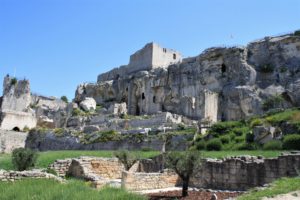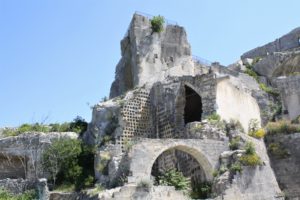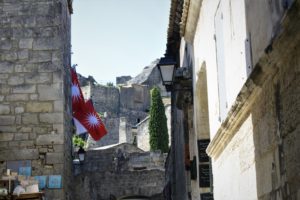Les Baux-de-Provence

Set in the heart of the Alpilles regional county park, Les Baux-de-Provence is listed as a heritage site. It’s even won the title of one of the Most Beautiful Villages in France. Considering the fact that there are plenty of beautiful villages in France, this is quite an honor.
So, why this designation? We wanted to find out.

For starters, the village literally sits on a rocky plateau. It sort looks like someone perched it there, overlooking the valleys, hills, and marshes below. With its panoramic views, you can see all the way to Arles and the Camargue. If you know where to look, you can see some patches of red earth. These are all that are left of the bauxite quarries, a mineral used to make aluminum.
The Baux outcrop is one of the last foothills of the Alpilles mountains. It’s this craggy cliff formation, with sheer drops of 20 to 45 meters that provided natural protection for the Chateau. And, the Chateau was crucial.
This location was important as far back as early prehistoric times. Defend and protect. In addition to the magnificent drop offs, there are several smaller outcrops where defending troops could see the enemy coming. These somewhat smaller fortresses acted as sort of warning system for the main Chateau.

Keep the Chateau safe. And, they did.
In the Middle Ages, the Baux lineage was one of the leading families in Provence, thanks to the land. They had control of over 79 towns and fortresses until the King took it over.
The Renaissance was a golden age for the town and any buildings in need of repair were rebuilt. Until 1631. Insurgents took it over, leading to a revolt. Cardinal Richelieu’s troops besieged it, once again demolishing it. The village of Les Baux was gradually abandoned until 1821, when a geologist discovered a red rock rich in alum earth…bauxite.
After WWII, the village began a new life as a tourist and cultural center. Raymond Thuillier opened Oustau de Baumaniere, an ambassador for gourmet cuisine which attracted all the world’s best-known names in food.
Then came that distinction of one of the “Most Beautiful Villages in France.”
Now, you can only visit the village by foot…which we did.

With its narrow alley-ways or streets, even the foot traffic gets congested at times. Winding our way up through the village, our goal was the Chateau at the top. Our self-guided tour let us explore as much as wanted, learning about the turbulent history, watching a giant catapult hurl rocks at incoming invaders, and experiencing what it would have looked like to watch an enemy approach from miles away.
Walking back into the village after exploring the Chateau, we were looking for lunch. The Renaissance facades, noticeable on many buildings, bring the memories of what this village once was back to mind. Small shops and restaurants now occupy those buildings.
A bottle of wine, lavender soap, a new Panama hat, locally grown olive oil, or perhaps a custom designed knife…whatever you’re looking for, you might see it here.
Restaurants? No shortage of these, from simple take-away deli sandwiches piled high with local meats, olives, and cheeses to sit-down organic meals to ala carte specialties. This village is truly a foodie one.
What did we discover here?
Plan on spending a full day. If you can, arrive early. Wander through the Chateau and its entirety, taking advantage of the free audio recordings. They help explain what you’re looking at and how it functioned many, many years ago. You’ll learn how they used that giant catapult, how they made their amour, where their food was kept, and where the wounded were treated.
Allow time to explore the village. Whether you’re shopping, exploring local fare, or intent on buying, take your time. Look at the buildings and imagine what they housed in their former lives.
Also, explore the type of restaurant and food you want. There’s a variety. So many choices…not enough time.
This a beautiful village in so many ways. It’s a village we’ll go back to. Maybe even stay longer next time…
If You Go: Les Baux-de-Provence is a French commune in the Bouches-du-Rhône department of the province of Provence in the Provence-Alpes-Côte d’Azur region of southern France
It
was after the Second World War that the village began a new life as a tourist and